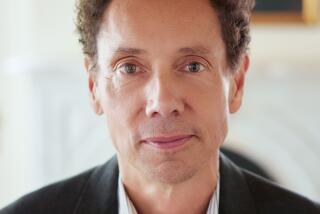Science’s ‘Tipping Point’ Helps Effort
- Share via
As people rummage around for explanations behind the plummet in crime rates in Los Angeles, it helps to remember that scientists have long studied the mechanisms of abrupt change.
After all, in the natural world, it’s not unusual for small hidden causes to trigger huge sudden effects.
Bombs explode. Earth quakes. Water sits on the stove doing nothing for what seems like hours, then suddenly bursts into a boil. Interstellar stuff accumulates into a huge cloud of matter that slowly, imperceptibly, gets denser and denser. At some critical point, it ignites into a star. Life appears on Earth and hangs around as pond scum for billions of years before suddenly cascading into a riot of creation.
The same thing happens in the social realm.
For decades, it seems that all physicists are men. A few women make major discoveries, have distinguished careers, yet their numbers remain well below a few percent. Suddenly, you look around at a scientific meeting and realize that females are no longer anomalies.
Or a nice, middle-class neighborhood begins to disintegrate in slow, imperceptible ways. An unrepaired broken window stares out from its house like a scar; a lawn goes to seed; a car gets a terminal chink and is left on the curb, abandoned to its own devices. Suddenly, the happy home becomes a slum.
In the 1970s, Harvard University economist Thomas Schelling studied the dynamics behind the sudden segregation of previously racially mixed neighborhoods. He found that small quantitative changes can lead to huge, sudden, qualitative differences.
Schelling found that this “tipping point,” as he called it, is extremely sensitive--one more family of the “wrong” race, and the whole neighborhood changes. A saturation point is reached, and all of a sudden, nothing looks the same.
Mathematician John Casti said that to his “physics-trained” eye, the tipping point looked like a sociological version of the kind of phase transition that takes place when water turns to ice. All it takes is a decrease of one degree, and wet stuff splashing in wild abandon out of a hose petrifies into a solid that keeps its shape and stays put.
How can a small, nearly imperceptible change create such enormous effects? Why can’t we seem to quantify the individual value of, say, tougher curfew laws in last year’s 11.6% decrease in serious crime in Los Angeles?
A physicist might describe such effects as nonlinear--meaning simply that effects do not react to causes in one-to-one ways. A rock rolling down a hill may do nothing more than nudge another rock down the hill. Given the right conditions, however, it might start an avalanche.
The conditions that produce nonlinear effects usually require many different connected things that feed on each other. A rock rolling down a perfectly smooth slope containing no other rocks will simply slide into oblivion with no effect on anything.
Getting a big reaction requires having a critical mass--of uranium in a bomb or rocks on a mountain. Some studies suggest that women in physics departments, for example, feel isolated and unwelcome until the number of females in the department (or class) reaches something like 15%. At that point, the atmosphere tips enough to change physics from unbearably icy territory to a habitable (if not always warm) environment.
What does all this have to do with falling crime rates? New Yorker magazine writer Malcolm Gladwell argued last year that New York City’s precipitous drop in crime was triggered by just such a “tipping point.”
For years, New York City had been working on improved methods of policing, graffiti removal, curfew enforcement and the like, with few visible results. As in Los Angeles, none of these incremental steps seemed to account for the sweeping scale of the change.
However, if you think of crime as an epidemic, the scenario becomes much clearer. Epidemics are nonlinear phenomena. As the number of people carrying an infectious disease increases, even slightly, each infected person spreads the disease to someone else. The spread multiplies the more it spreads. At some critical “tipping point,” the flu (or AIDS) outbreak becomes an epidemic.
In the same way, a single rundown house or vacant lot or cracked car window can be the tipping point that ruins a neighborhood. Suddenly, the atmosphere changes from restraint and respect to license to destroy. “A small deviation from the norm can set into motion a cascade of vandalism and criminality,” said Gladwell.
Gun violence gathers steam in a similar way. More people have guns and the inclination to use them. Suddenly, carrying a gun seems like a defensive necessity. One bad deed deserves another. Retaliation becomes a way of life and, presto, a society blows up in your face.
Gladwell unearthed studies showing that the same “tipping point” phenomenon could explain everything from the rise of sexual intercourse among teenagers to the dearth of role models in troubled neighborhoods. “When the number of professionals [living in a neighborhood] dropped below 5%, the problems [teenage pregnancy and high school dropout rates] exploded.”
The good news--and the ultimate reason behind the drop in crime rates--is that positive influences are also catching and have consequences far beyond the scale of their causes. Operating in isolation, it’s unlikely that enforced curfews, graffiti removal, community policing or even an aging population would be enough to turn back a violent crime wave. Together, they work what seem like miracles.
The danger, said Gladwell, is that you need to reach a critical mass before any set of solutions can work. When people argue that there’s no point in putting more money into inner city schools, say, because the investment hasn’t produced tangible results, they’re neglecting nonlinear dynamics.
Instead, it’s more probable that the money hasn’t been enough to make a difference--that the efforts to help haven’t yet reached the tipping point.






